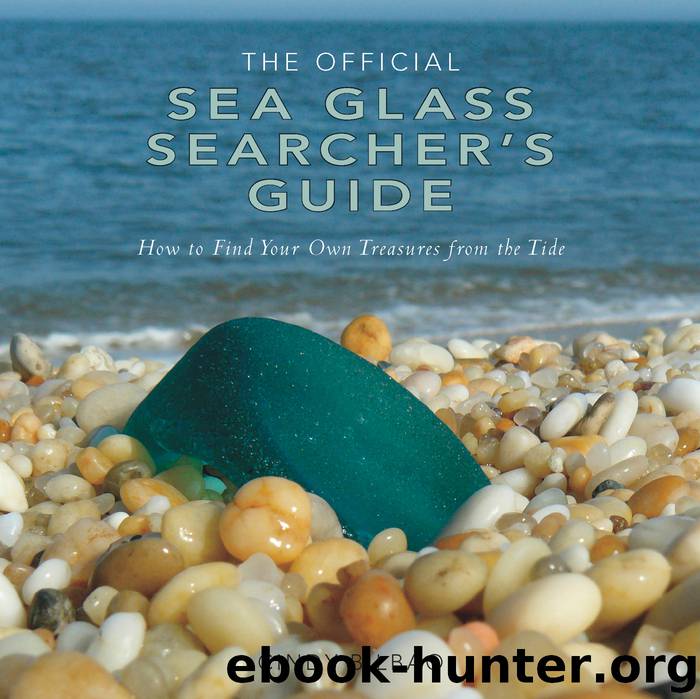The Official Sea Glass Searcher's Guide by Cindy Bilbao

Author:Cindy Bilbao
Language: eng
Format: epub
Publisher: Countryman Press
Published: 2014-03-01T16:00:00+00:00
6 Consider investing in good rain gear. I mean the works—a nice Gore-Tex jacket and pants. When you’re on the beach, looking for sea glass, carrying an umbrella just isn’t practical. You might not be obsessed enough to go out there in the pouring rain, but my fellow hardcore searchers know that I’m not exaggerating when I say I go out rain or shine. Only lightning will keep me away from the beach, so good rain gear is very important.
CHAPTER 6
KNOW THE LOCATION
The best place to search for sea glass is in an area that has reasons why old broken glass would be resting in sand at the bottom of the ocean.
Spend some time researching various regions of the coast you’d like to visit. Determine if an area would be a good place to find sea glass. There are five factors to pay attention to in order to determine areas where old glass might be buried. Along coastlines around the world, there are many, many places like this.
1 Dig into the history of the region. During the early 1900s, seaside resorts became popular with the public, and there were a plethora of very popular grand resort towns all along the coastlines of both the oceans and the Great Lakes region. The key here is that back then we didn’t have recycling or plastic bottles, and we were not quite as concerned with environmental issues as we are today. Glass was discarded into the oceans freely—everything from discarded tableware to empty bottles that had contained medicines, colas, beers, and more. It was common practice for coastal communities to discard their trash into local ocean or river waters. If you can find a beach town that was popular fifty or more years ago, especially if many resorts existed there, and there were year-round residents, there’s a good chance that lots of old glass has been buried at the bottom of the ocean nearby, which will eventually end up as sea glass on the beach.
2 Locate beaches near areas where there used to be lots of manufacturing. Chances are, these old factories discarded glass regularly into the ocean or local river systems, as was the common practice. Back in the 1800s manufacturing areas tended to be located near waterways because water was a needed resource and because shipping provided needed transportation.
3 Find beaches that are close to old shipping ports. If a beach is close to a shipping route, there’s a strong possibility that, long ago, glass and pottery were thrown overboard. In times past, it was common for ships to carry heavy pottery as ballast, which sometimes got discarded into the water when it was no longer needed. Also, passengers on ships often discarded refuse into the waterways, because at that time it was not known to be environmentally harmful.
4 Look for local shipwrecks. If you can find a beach near old shipping routes, do some research to learn whether that area had any shipwrecks. Shipwrecks are plentiful up and down the Atlantic coast, for example, and many a ship’s cargo has been lost to the sea.
Download
This site does not store any files on its server. We only index and link to content provided by other sites. Please contact the content providers to delete copyright contents if any and email us, we'll remove relevant links or contents immediately.
Periodization Training for Sports by Tudor Bompa(7341)
The MacArthur Bible Commentary by John MacArthur(4246)
The Body: A Guide for Occupants by Bill Bryson(3815)
The Sports Rules Book by Human Kinetics(3597)
What It Really Takes to Get Into Ivy League and Other Highly Selective Colleges by Hughes Chuck(3224)
Marijuana Grower's Handbook by Ed Rosenthal(3126)
The Sprouting Book by Ann Wigmore(3056)
Salt, Fat, Acid, Heat: Mastering the Elements of Good Cooking by Nosrat Samin(2665)
The Martian by Andy Weir(2620)
Classic by Mary Berry(2505)
The Bread Bible by Rose Levy Beranbaum(2478)
Sapiens and Homo Deus by Yuval Noah Harari(2420)
The Marketing Plan Handbook: Develop Big-Picture Marketing Plans for Pennies on the Dollar by Robert W. Bly(2420)
Harry Potter 4 - Harry Potter and The Goblet of Fire by J.K.Rowling(2418)
Martha Stewart's Baking Handbook by Martha Stewart(2336)
50 Economics Classics by Tom Butler-Bowdon(2070)
Screenplay: The Foundations of Screenwriting by Syd Field(2063)
The Cambridge Grammar Of The English Language by Rodney Huddleston Geoffrey K. Pullum(2051)
The Plant Paradox by Dr. Steven R. Gundry M.D(2049)
